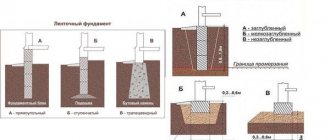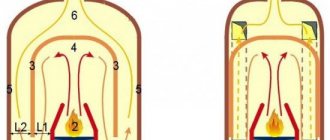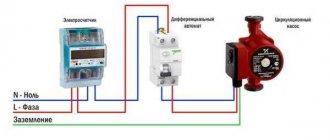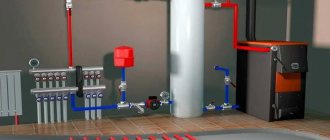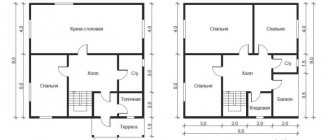Organizing high-quality and efficient heating of a cellar or basement in a country house is not as simple as it seems at first glance. Especially if you want to make the underground room suitable for growing plants or for long-term stay of people. Heating the floors using a heated floor system alone will not help here.
Homeowners often use heaters to increase the air temperature, although they look bulky in the basement and do not always solve the desired problem. A good solution would be to install a heating system in the basement, however, from a technical point of view, this is a significant amount of work.
Arrangement of heating of underground premises
Heating in the basement is designed to create an optimal temperature regime, which changes during its operation.
As a rule, water or air systems are used. The loads of the basement heating system are determined based on the heat balance of the basement. When the basement is not in use by the owner, a high temperature can be maintained without using a heater - at a depth of more than two meters, the temperature in some regions does not drop below - degrees Celsius.
Proper thermal insulation of basement walls keeps the temperature at a level of up to degrees Celsius without additional heating systems. In addition, communications and equipment also emit heat, which makes it possible to increase the temperature of the room.
Requirements for gas equipment in the basement
When installing gas boilers and other equipment, you must follow the rules for their installation and use. A gas boiler is installed if there is a boiler room in a private house. The installation of gas equipment in the underground areas of an apartment building is strictly prohibited.
The requirements for installing gas units are as follows:
- Ceilings in the room must be at least 2.5 meters;
- The basement area cannot be less than 4 square meters;
- Natural lighting must be provided, and for every ten square meters of the room there must be at least one window opening measuring 0.3 sq.m.;
- Doorways should be at least 80 centimeters in width;
- The basement must be equipped with high-quality ventilation;
- It is necessary to make a gas analyzer that can use an electric valve to turn off the gas supply in the event of a problem.
Operation of gas equipment in the basement must be carried out exclusively in accordance with the following rules:
- With open doors to the street,
- With a hood, the draft of which is at least three volumes of air per hour;
- The air flow is calculated by the sum of the exhaust volume with the amount of air required for burner operation;
- A window must be equipped.
Installation of a coaxial chimney for a gas boiler in the basement
As a rule, manufacturers supply this equipment along with the boiler. A classic hood is not required for such devices; combustion products will not be removed from the room.
The device is characterized by the presence of two tubes, which are located one inside the other without contact. They are taken outside. A larger channel is made to remove combustion products, and a small tube brings in fresh air.
The advantages of such a device.
What technical conditions must be met?
In order for the installation of heating equipment in a basement or basement to remain legal, certain technical conditions must be observed. Read more about them below:
- the number of boilers that will be responsible for heating the house as a whole should not exceed four units;
- the total power of the devices that make up a single heating system should not exceed 200 kW;
- The owner has permission to install a boiler that runs exclusively on natural gas.
Even if all of the above requirements are actually met, it is still too early to start installing a heating source. It is necessary to order a design for the future boiler house from the relevant authorities. This document must be signed and officially approved by the licensed business.
Large gas installation in the basement of a house Source bk.biz.pl
Option for placing equipment in the boiler room of a private house with gas heating Source vodakanazer.ru
Main types of heating systems
We can immediately distinguish two main types of heating:
- Water heating of a private house, which involves installing radiators and a boiler (gas or electric).
- Stove heating, the organization of which requires the presence of a “potbelly stove” or stove.
Water heating operates on the basis of a boiler (it can be electric or gas). One of the main advantages of such a heating system is the constant availability of warm water.
Simple water heating system: 1- boiler; 2 - expansion tank; 3 - supply pipe; 4 - radiator; 5 - return pipe.
When installing stove heating, the installation of a “potbelly stove” or stove is required. This type of heating is more economical both during installation and during further use, which is its main advantage. In addition, in this case there is no need to look for a place to install a bulky boiler. The stove will produce enough heat to heat a small basement of a private house.
But for the system to operate effectively, it is necessary to provide a chimney. Here you need to approach the issue responsibly and accurately calculate the parameters of the pipes to organize sufficient traction.
Expansion tank requirements
From the point of view of current standards, an expansion tank must have been organized in a gas autonomous heating system. The installation of such a design is necessary to compensate for the missing amount of water taken from the water supply when starting to power the system.
An expansion tank is also necessary to relieve the resulting water pressure during heating. Additionally, a device can be inserted, which will be responsible for feeding the main heating circuit.
On a note! The current SNiP allows the use of polypropylene pipes with aluminum reinforcement for soldering the heating system. It is important that the use of such material meets two conditions: withstand pressure up to 3 bar and a coolant temperature of 105 degrees.
Which heating method to choose
Heating a basement or cellar is a rather complicated issue. Here it is necessary to approach the issue of choosing the type of heating of the room as responsibly as possible, based on the wishes and requirements of the owner. For example, if you need to heat the basement in a seasonal home (that is, during the cold spring and autumn months), then installing a simple heater will be enough.
On the other hand, if you plan to turn the basement of a country house into a full-fledged living space, then it is necessary to arrange more efficient heating. The best option in this case seems to be installing a furnace or boiler. It is worth noting that for the installation of a gas boiler it is necessary to allocate a separate room, and its operation must be coordinated with the relevant services.
https://podvaldoma.ru
As a rule, multi-story buildings have a basement. Initially, the purpose of the basement was to create a place where heating system equipment and pipelines could be placed. Then they began to use it for storing anything technical, and then for storing vegetables, fruits, and pickles, as in a cellar. Recently, due to the high cost of space and rent, basements have begun to be used for completely different purposes.
High-quality thermal insulation in the basement will ensure less heat loss.
The ground floor can often be seen converted into a store, warehouse, office and even residential premises. If the BTI and technical supervision services do not have any questions or complaints, then such re-equipment in basements is quite acceptable, but requires the installation of heating.
Cellar and basement: differences
Many people are often confused by thinking that a cellar and a basement are the same thing, but there are several differences between these rooms:
- The cellar is always cold, the basement can be heated;
- In the cellar, the maximum height of the walls can be 1.9 m. In the basement this is the minimum, and only if there is a vegetable warehouse in it. Height The walls in the basement under the house, in which there will be technical communications, cannot be less than 2.2 m high. If the basement is intended for housing, the height of its ceilings should be 2.5 m.
- A basement is just a room whose walls are at least half in the ground. If the depth is smaller, then it is not a basement, but a cellar (if it is separate), or a ground floor (if it is under a building).
If you don’t have a cellar, storing food in the basement is also possible.
Heating using electrical appliances
Electrical appliances for heating basements are the simplest and most cost-effective option. Today, a heater is an indispensable device that is used when it is necessary to maintain a certain temperature regime.
In order for heaters to work properly, the basement of a private house requires high-quality electrical wiring designed for their total power.
Electrical equipment can be very different. Let's consider its main types.
Convector heaters
To fully heat a large basement of a private house, convectors are best suited. Heaters of this type will help cope with cold air even in the bitterest frosts. Convectors can be made in different types of designs, so you can choose the most convenient type (on the wall or on the floor).
Among the main advantages of such heaters are the following: the room warms up quickly and fully, the device is easy to install, it does not make noise, it can heat the entire building or individual rooms. The main disadvantage is the serious energy costs.
Oil heaters
Previously, equipment of this type was used quite widely. For heating, the oil in the radiator must first warm up, after which it will begin to release heat into the room. In this case, the time required to heat a cellar or basement is much greater than in the case of convectors.
Oil heaters are quite cheap, easy to use, but have considerable weight and have some installation restrictions. Main advantages: long service life, absence of noise during operation, affordable price, ease of installation and maintenance, ability to move.
Infrared heaters
Equipment of this type is used extremely rarely for heating a basement or cellar. The point is that the devices operate in such a way that they only heat up those objects and surfaces that are under or in front of them (if the device is mounted on a wall). Thus, it will take considerable time and electricity to warm up the basement completely.
The main advantages of devices of this type: quiet operation, high level of reliability and long operation, safety in use, increased efficiency, the ability to heat a certain area. Among the disadvantages we highlight: stationary installation, high ceilings for installation, with prolonged use there is a possibility of overheating.
Infrared heater mounted on the ceiling.
Advice from professionals
Before you start building a basement in a building, it is important to know the required stages of the process, which will be useful both when ordering construction from craftsmen, and when doing the work yourself.
To ensure that the building structure from the basement to the roof is strong and reliable, the following steps must be followed:
- Soil analysis, you need to know its characteristics and groundwater content.
- Planning, it is necessary to prepare design documentation in accordance with construction norms and standards.
- Preparing the area, draining in case of high humidity, digging a pit.
- The construction of the basement is carried out using high-quality building materials, observing technical standards.
- The final stage of work includes finishing the walls, installing wiring, ventilation, and heating as necessary.
Building a basement in a house is not an easy process, which involves a lot of work, so that everything is of high quality and reliable, it is better to turn to a specialized construction company with experience for help.
Selecting a heating option
How to choose the right heating in the basement? A difficult question, the answer to which considers several options. There is no need to rush when choosing heating for the basement; it is important to calculate all the work, in addition, decide in economic terms what will be more profitable and what will be suitable and almost ideal for your room
House heating scheme.
Only after this you have to choose which type of heating is most suitable. To measure the area of the basement, as well as temperature fluctuations, you will need:
- roulette;
- pencil;
- note paper;
- thermometer;
- barometer.
You should record temperature and humidity readings over a period of several days to determine what will work for you. Then analyze the indicators that will show you what humidity is in the basement and how much heat is required for heating. There is equipment that not only heats, but also dries the air, or vice versa, humidifies it. In addition, you will have to take into account the structure of the foundation of the room, repairs in the room, the presence of doors and windows.
It is also important how isolated the basement is from general communications. If there is a possibility of connecting to general heating, remember that problems may arise with payment calculations, since it is not always possible to calculate the correct numbers. However, there are options where individual heating is not suitable for your specific basement.
Heating the basement floor
Before heating the basement floor, it is necessary to take measures to reduce heat loss into the walls, as well as reduce the negative consequences of heating.
1. It is necessary to get rid of two factors - high thermal conductivity and moisture permeability. To do this, ideally, external hydro- and thermal insulation is performed, which requires digging out the entire foundation. The feasibility of such an event is to transfer the walls of the basement to a zone of elevated temperatures with lower humidity by shifting the dew point (0 degrees) in the insulation.
2. If it is impossible to carry out external work, it is permissible to perform insulation inside the basement. But in this case, the walls will completely freeze, which will significantly reduce the service life of the entire building. Therefore, internal insulation becomes advisable only when a sufficiently high temperature (7-15 degrees) is detected in frosty weather.
3. Moreover, it is worth taking a balanced approach to the need for internal insulation; perhaps increased energy costs for heating the room will be more profitable than the costs of thermal insulation materials with “driving” the foundation into harsh operating conditions.
4. Having solved the dilemma of the operating conditions of the basement floor, you can begin heating. Ideally, the heater should be located in the basement. But this requires a minimum ceiling height of 3 m and a specialized ventilation system. But with this arrangement of the boiler, it is possible to organize both forced circulation of the coolant and natural one.
5. If it is impossible to mount the boiler at the lowest point of the heating system, the question arises about choosing the type of heating. Perhaps, separate electric heating will become more economically profitable, because the need to lay pipelines disappears, and such heating is not subject to periodic operation, which is unacceptable with water heating.
When organizing heating of the basement, do not rush to lay pipelines, but objectively and rationally consider all heating options from an economic point of view.
Chapter 33. Utility Payments for Leases
How is the amount of payment for heating in non-residential premises of an apartment building determined in the absence of metering devices? for gas and electric energy - by calculation agreed upon by the resource supplying organization with the person who entered into an agreement with it, based on the power and operating mode of the consuming devices installed in these premises; d) for heating - in accordance with subparagraph 1 of paragraph 1 of Appendix No. 2 to the Rules [note: according to the consumption standard in Gcal/sq.m., i.e. the calculation is the same as for apartments]. Is the rent paid by owners different from the rent paid by tenants? The rent for residential premises does not depend on the number of registered people.
The Housing Code of the Russian Federation establishes (Art.
Communities › Construction (and everything connected with it) › Blog › Housing in the basement
Hello, dear builders and near-builders! After a big disaster (the house burned down), we have a concrete base below zero (a monolith 300 mm wide, two meters high, with floor slabs). There was a hole about one and a half by one and a half meters left in the basement at the top. And now life gets hot, but there’s no money to raise the house. There is this option, waterproofing the walls (mastic plus sheets of technoplex weaving or 150), backfilling the front wall with earth (the area has an uneven slope of about 1.5 m by 8 m, that’s why I made the basement), cutting out a door and a couple of windows in the walls, making a cover hatch, and then insulation from the inside, some kind of floors. Unresolved questions: how to waterproof the slabs on top; is there a heating option in winter; temporary concrete or wooden floors; Is it possible to do all this without ruining yourself, like the dampness there and all that? PS: please write to the point. Everyone is good at dissuading it.
Who pays for heating in a rented property?
Therefore, in practice, organizations prefer to use the second method. 2. Rent is fixed, “utility” is variable.
With this method, the amount of rent in the contract consists of two parts: - fixed (basic) payment; — variable (additional) payment. The fixed (basic) payment is the actual payment for the area of the rented premises (building), i.e.
rental fee. The variable (additional) part of the rent represents the cost of utilities consumed by the tenant in the billing period. For example, between organizations “Alpha” (lessor) and “Omega” (tenant) a lease agreement was concluded for non-residential premises with a total area of 200 square meters. m. The terms of the agreement stipulate that the tenant pays monthly rent in the amount of 33,400 rubles. The agreement stipulates that the tenant pays monthly rent in the amount of 167 rubles. for 1 sq. m. In addition, the tenant undertakes to pay monthly the cost of utilities (hot and cold water supply, heating, energy supply, gas supply) in proportion to the area of the rented premises based on invoices issued by the lessor. The landlord is required to confirm the cost of utilities paid by the tenant by providing utility bills. In addition, landlords and tenants can enter into independent agreements to reimburse utility costs. For example, an agreement to reimburse the costs of paying utility bills, or an agreement to pay for utility bills, or an agreement to participate in the costs of paying utility bills, etc.
Most organizations operate in rented premises. In order to properly operate the premises, tenants use electricity, cold and hot water, heat, gas, i.e.
utilities (clause 4 of article 154 of the Housing Code of the Russian Federation). The list of provided utilities is established in each specific case in the lease agreement. Thus, when receiving property for rent, the tenant becomes obligated not only to pay rent in a timely manner and in full, but also to pay for utilities, unless otherwise provided by law or agreement (Clause 2 of Article 616 of the Civil Code of the Russian Federation). As a rule, tenants pay utility bills not to the providers of these services, but to their landlords, thereby compensating their utility costs.
Basements in an apartment building have a variety of functions. It all depends on the quality of the structure and the location of the central communications, thanks to which water and heat are supplied to the apartments.
Most often, the basement is the property of the residents of this house, and can be equipped for organizing shops or cafes. Recently, it has become popular to organize gyms in basements, but for various types of events it is necessary to think carefully and qualitatively, since air masses naturally do not circulate very well.
It is characterized by high air humidity, which can negatively affect human health. For this reason, various fungal colonies and mold will begin to appear on the walls of the room, which are quite difficult to get rid of.
Advantages and disadvantages of a basement
The main advantage of a basement in an apartment building is the concentration of all necessary communications for functional work. From the basement it is carried out through ventilation ducts, which are located in each apartment.
There is also a central water supply pipe and heating pipes. As a rule, flow meters are installed on such pipes to monitor the total flow of the entire house and each resident individually. The basement also houses the central sewer system, to which all apartments in the building are connected.
The basement can be used as a storage room, but this is only if a certain space is provided there for such purposes. Previously, the basements were used as bomb shelters. Today there are still some basements that have benches or places to rest.
The downside of the basement is the dampness and mustiness of the air due to poor ventilation and lack of natural light.
Advice. To effectively use the basement, it is necessary to ensure high-quality ventilation and waterproofing.
Do I need to heat the basement floor?
Everything about water supply and sewerage
Pumping stations and wastewater treatment plants
Sewer
Plumbing
Firefighters
The Admiral plant produces complete pumping stations for water supply, fire fighting and sewerage needs. Admiral plant website: admiral-omsk.ru
Gas or electricity
It is recommended to use a network voltage in the basement no higher than 42 V.
So, an important factor in determining which basement heating you choose will be the purpose of the room. If you plan to equip a living space in the basement, you will need full heating so that it is warm even in the most terrible frosts. Options for steam heating and a gas boiler will be relevant here, if the design provides for this. If the ventilation of the basement is poor, then first you need to finish it, plastering all the cracks where outside air can come from.
If you are planning an office space or a store, you can choose a heating system based on radiators that operate from the electrical network and are capable of heating rooms with a fairly large area. Such heating in the basement will also dry the air, so it is ideal for rooms with high humidity.
But with this choice of heating, it is worth paying attention to the power of the electrical network where the radiator will be connected. If an office is heated, where there are already a lot of electrical appliances and electronics, the network will not be able to withstand such voltage and there will be a need to install additional equipment, which will incur certain costs in addition to paying for electricity
If the humidity in the basement exceeds acceptable standards, then in addition to heating, you should also worry about drying the air, since moisture destroys the basement as a whole and negatively affects the quality of the air you will breathe. This way you can create comfortable conditions on the ground floor.
If you plan to store something in the basement, use it as a warehouse, and the relatively low temperature will not interfere with storage, you can use an ordinary battery, and installing it will not require any special changes in the heating design throughout the house.
Infrared heating is an alternative to boilers and batteries. This option has several advantages: short installation work, ease of installation of equipment. It can be arranged quickly, conveniently, simply and efficiently.
In any case, when installing any heating, consultation with certain responsible services is first necessary. You can only install a heater in the basement yourself; in all other cases, you will need the help of specialists, professionals in their field. Calculations that will be associated with installing heating in the basement are also best left to professionals.
The issue of material for equipment is also important. What material is best to choose the pipes that will be installed, what batteries are best to choose, or what type of radiator will be of better quality? All these are individual parameters for each specific basement, and only correct calculations and observations of air and humidity can show this.
Peter Kravets
Reading time: 4 minutes
A A
Basement heating is of interest to both owners of multi-storey buildings and private country cottages. They are often equipped with bars, billiard rooms, cafes, recreation areas, gyms, saunas or small cinemas.
Insulation of the basement space
If the question arises about the need to insulate the basement, you need to consider what it gives:
- The temperature regime is never sub-zero;
- Protects the room from condensation and dampness;
- Extends the life of construction by preventing excess moisture;
- Prevents the appearance of mold and fungal organisms on the walls, which contribute to musty air;
- Protects the foundation from moisture and premature destruction.
There are several types of basement insulation:
- Internal, the simplest, it requires additional waterproofing in the room to prevent condensation between the wall and the insulation;
- External, protecting the outer wall from freezing, not taking away meters inside, but it is carried out during the construction of the building;
- Combined, which provides internal and external insulation simultaneously with double-sided waterproofing, is the most effective.
The method of insulation depends on the following circumstances:
- Purpose of the basement space;
- Room humidity level;
- Heating in the basement;
- The presence of a drainage system around the base.
On the shelves of construction stores there is a sufficient assortment of insulation, the choice of which depends on the owner of the future home.
The most popular materials for basement insulation are the following materials:
- Polystyrene foam, the most cost-effective and accessible. In the process of thermal insulation, foam plastic is used whose density is 25 kg/m. cube It is popular due to its technical properties:
- Light weight
- Rot resistant
- High thermal insulation
- Water repellency
- Long service life.
Therefore, the use of foam plastic for thermal insulation of the basement is one of the most well-known ways to improve the thermal insulation of the basement space. But you need to take into account that polystyrene foam is not used in rooms with a high risk of fire in order to prevent a fire, because it is flammable and, when burned, releases toxic substances harmful to the body;
- Expanded polystyrene, a foam-like material with the same properties, but with a higher density, therefore stronger. It's more expensive, but it doesn't crumble during processing.
- Polyurethane foam, material for thermal insulation in the form of spraying. A special feature of polyurethane foam is its ability to fill the smallest cracks. It does not allow moisture to pass through, does not rot, does not burn, and creates complete tightness in the room. An insulated basement with polyurethane foam will create a good layer of insulation on the outside. The disadvantages of this insulation are the high price and the inability to carry out the work independently;
- Mineral wool is used as insulation indoors if there is no moisture in it, since when wet it loses its insulating properties;
- Expanded clay, a loose type of insulation that has excellent thermal insulation properties, but its use is best suited for thermal insulation of the floor and external foundation as a drainage layer.
The type of insulation and its thickness are selected individually for each individual case. It is better to entrust the selection of thermal insulation material to a specialist who will calculate the required thickness, taking into account many factors. Or you can make calculations in person, using recommendations approved by the government.
Organization of thermal protection at home
In places where heating will be done in the basement of a private house, it is necessary to insulate the external walls, especially the parts that will be in direct contact with the ground. This will help keep the heat inside and prevent condensation from forming.
In basements without heating, insulation with heat-protective materials is done, as for a heated one, only additional layers can be added to the ceiling of the room to prevent the cold from penetrating into the upper floors.
With external thermal insulation, the basement receives the following advantages:
- There are no cold bridges through which wind and frosty air enters the room;
- When condensation forms, it does not have time to cause a destructive effect on materials and the room;
- The useful space inside the basement does not become smaller;
- It is convenient to inspect structures, which allows you to quickly notice their damage by fungus or mold, as well as defects due to damage from insects and rodents.
Among the disadvantages it is necessary to note:
- It is necessary to protect the layers of thermal insulation from mechanical damage for the entire period of use of the house, with the cost of protective devices being significantly greater than the layers of thermal insulating material themselves;
- It is difficult to protect against damage from insects; disinfestation is done using poisons and other toxic substances, which is not always applicable in a residential building;
- When facing with brick, cold can penetrate, which will reduce the heat level in the room.
Even when designing the structure, protective work is planned against the following factors:
- Exposure to groundwater, which, if it gets into the basement, is difficult to dry, especially in terms of enclosing structures;
- When pouring, moisture in the concrete mixture enters the room for a long time, giving dampness and a musty smell;
- Capillary rise of water from different sources through capillaries in the materials from which the basement was built is possible;
- The air in the room also forms moisture through condensation; the inner layer of thermal insulation is not capable of ensuring absolute tightness, so condensation may appear on the walls of the base. It is also formed from gases from the soil, which can penetrate the entire perimeter of the basement;
- For internal insulation of a room, materials are often used whose level of water penetration is quite high, and when wet their characteristics are reduced. Then it is necessary to protect them with individual waterproofing work;
- Internal thermal insulation layers create difficulties when draining the basement. Moisture from soil, concrete and capillary water from base materials are very difficult to remove and require long-term drying. It is required to make high-quality waterproofing;
- The walls that are below ground level are cold, and the warm and humid air of the basement somehow affects them from the inside, which leads to the formation of moisture with subsequent destruction of materials.
When equipping a structure that protects from damage, additional layers of thermal protection can be made, both outside and inside. But they have the same disadvantages as the base, only at the same time they increase the estimate several times.
The prospect of heating the basement
Before heating the basement floor, it is necessary to examine its condition and analyze the feasibility of such an operation.
In the case of new houses built in accordance with the technology of insulation and waterproofing of the basement, the problem of heating the basement is only in the correct installation of equipment and wiring.
But with buildings that have served for more than 10-15 years, problems may arise. To determine the condition of the foundation, it is necessary to conduct a thorough inspection of the walls, both inside and outside. Internal research consists of:
• Temperature measurement in winter without heating the room. If the temperature is close to zero, then your base is poorly insulated, which means that organizing heating without carrying out an insulation complex will become a real waste, and the foundation inside will begin to rapidly deteriorate.
• Determination of humidity under different weather conditions. Detection of damp walls is a sign of impaired waterproofing and poor ventilation. It is necessary to establish the cause of moisture formation, because... heating will only superficially solve the problem, and most of the heat from heating the basement will be spent on drying the room.
• Search for cracks and damage in the basement walls. If structural damage is detected, it is necessary to restore the surfaces, and in case of significant damage, external repairs cannot be avoided.
• Don't forget to examine the floor. It is most susceptible to destruction due to high humidity and large temperature differences. Often they simply fill the floor without organizing waterproofing, which leads to its accelerated destruction and the formation of a porous structure through which moisture penetrates intensively.
External inspection consists of searching for structural damage, and it is advisable to dig out at least part of the base to ensure the presence of hydro- and thermal insulation. If they are missing, then you should think about the benefits of heating the basement floor, because you will be heating the ground to a greater extent.
Heating in a rented premises
Property transferred to the company under a lease agreement must be suitable for use based on its actual purpose. Provided by IP Lukoyanova Yu.V. non-residential premises are provided with a heat supply system, through which the heat necessary for the normal operation of the property is supplied.
Due to the fact that the use of leased non-residential premises involves the consumption of supplied energy resources by the tenant, the landlord, as the owner of the premises, is responsible for ensuring conditions for the tenant’s access to utilities, and, consequently, for their payment to resource suppliers. These conclusions of the court of first instance correspond to the legal position set out in the Resolution of the Presidium of the Supreme Arbitration Court of the Russian Federation dated May 21, 2013 N 13112/12. Under such circumstances, claims against IP Lukoyanova Yu.V. Ulyanovsk, st. Karbysheva, 30, is in municipal ownership. In the period from 07/01/2008 to 03/09/2012, the said premises were rented to entrepreneur Yu.V. Lukoyanova.
in accordance with agreement
N 8883/1415, concluded between her and the City Property Management Committee of the Ulyanovsk City Hall. According to clause 2.2.8 of the agreement, the tenant is obliged, within two weeks from the date of conclusion of this agreement, to conclude agreements with special organizations (either the balance holder or the responsible tenant) for the supply of the premises with energy and other resources, maintenance of the premises, as well as maintenance of the building in proportion to occupied area.
However, the heat supply agreement between individual entrepreneur Yu.V. Lukoyanova and the resource supplying organization JSC VTGC was not concluded.
Installation of heated floors in the basement
Having a heated floor in a living space will be an excellent solution for creating a comfortable environment. Often, heated floors are installed even when the house has stove heating, since cold air masses that arise during ventilation of the room pass through the floor.
It must be taken into account that when installing a heated floor in the basement of a private house, special attention must be paid to thermal insulation and waterproofing of the foundation base. It is recommended to use a combined solution as insulation - mineral wool and expanded polystyrene
Installation of an additional waterproofing layer is necessary if the area has a high groundwater level or there is a possibility of seasonal flooding of the basement.
Installation options for heated floors. Click to enlarge.
If the groundwater level is high, a drainage system should be provided on the site
This is very important if an electric heated floor is installed in the basement, which should not be exposed to moisture under any circumstances.
Ventilation arrangement: important points
The best option is natural ventilation. It is most often organized in the ceiling area. If this is not possible, then they do it in the wall, directly under the ceiling. It is noted that for high-quality ventilation of a room with installed equipment with a power of 1 kW, 8 cm2 of inflow is sufficient.
It happens that it is difficult to organize ventilation from the street, so air is taken from the adjacent room. In this case, a boiler with a power of 1 kW will require up to 30 m2 of inflow.
Sometimes natural ventilation cannot be realized. In this case, they resort to artificial methods, for example, installing a fan, which is connected to electricity. They also use duct installations. It is necessary to select mechanical devices according to power, which is pre-calculated according to this principle: the width and height of the room are multiplied by the length.
Forced ventilation in the basement where heating is installed Source drive2.ru
The most efficient ventilation units are those with an aluminum or copper casing. These materials are known to resist melting.
Types of basements
SNiP 31-02-2001 regulates the types of underground premises as follows:
Basement
It is a floor with a floor in a room that is below the ground level by half the height of the walls. A room of this type can be forced-heated with additional equipment, or without heating.
Underground
The space located under the house between the ceiling of the first floor and the ground. The bottom of the building, where communication pipelines are laid and equipment is placed, is called the technical underground.
Ground floor
The basement of a house is characterized by a floor level below the ground, recessed to a distance of less than half the height of its walls. Lighting, heating and other types of work are done in the basement, since this room has great functionality and is used as an additional floor of the house.
Basement heating problems
Heating the basement is not a waste, but a real necessity. The basement is the most vulnerable place of the entire house, so the basement requires special attention so that moisture and low temperature do not quickly destroy it.
The basement floor is located largely underground, so it is heavily influenced by many negative factors, so during its construction, even the smallest deviations in technology lead to poor operating conditions, which affect the microclimate of the room.

